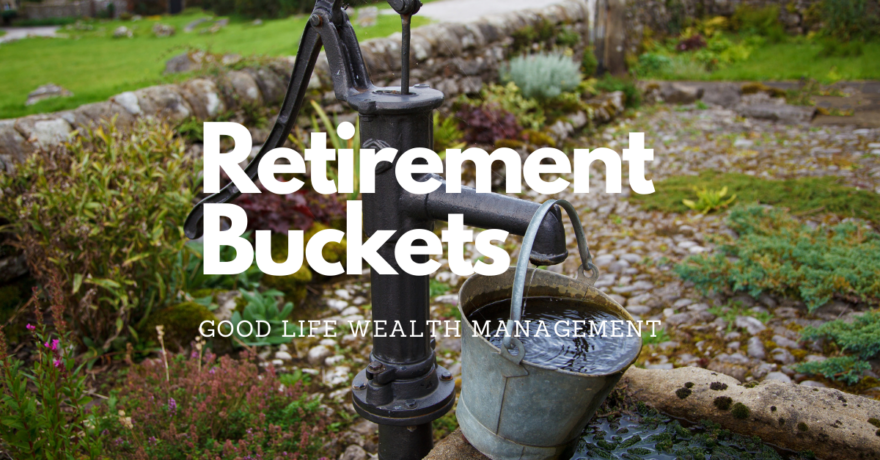Our fifth and final installment of our series on retirement income will cover the strategy of five-year retirement buckets. It is a very simple approach: you maintain two buckets within your portfolio. Bucket 1 consists of cash and bonds sufficient for five years of income needs. Bucket 2 is a long-term growth portfolio (stocks).
We could start with up to a 5% withdrawal rate. Let’s consider an example. On a $1 million portfolio, we would place $250,000 in Bucket 1. That is enough to cover $50,000 in withdrawals for five years. Bucket 1 would be kept in cash and bonds, for safety and income. Each year, you would take withdrawals from Bucket 1.
Bucket 2, with $750,000, is your stock portfolio. The goal is to let this money grow so that it can refill Bucket 1 over time. In years when Bucket 2 is up, we can refill Bucket 1 and bring it back up to five years worth of money. At $750,000, a 6 2/3% annual return would provide the $50,000 a year needed to refill Bucket 1.
Addressing Market Volatility
When the market is flat or down, we do not take a withdrawal from Bucket 2. This addresses the big risk of retirement income, having to sell your stocks when they are down. Instead, by having five years of cash in Bucket 1, we can wait until the market recovers before having to sell stocks. That way, you are not selling stocks during a time like March of 2020, or March of 2009! Instead, we hold on and wait for better times to sell.
Historically, most Bear Markets are just for a year or two, and then the market begins to recover. Sometimes, like this year, the recovery is quite fast. The goal with our Retirement Buckets is to never have to sell during a down year. And while it is always possible that the stock market could be down five years in a row, that has never happened historically.
Retirement Buckets is different from our other withdrawal strategies, such as the 4% rule or the Guardrails strategy. Those strategies tend to have a fixed asset allocation and rebalance annually. The Retirement Buckets Strategy starts with a 75/25 allocation, but that allocation will change over time. Our goal is not to maintain exactly 25% in the cash/bonds bucket, but rather to target the fixed amount of $250,000. If the market is down for two years, we may spend Bucket 1 down to $150,000.
Stocks for Growth
For most people, having five years of cash and bonds in reserve should be sufficiently comfortable. However, if you wanted to increase this to 7 years, a 65/35 initial allocation, that would also work. But, I would suggest starting with at least a 60% allocation to stocks. That’s because when Bucket 2 is smaller, you need an even higher return to refill the $50,000 a year. If you started with 60/40 ($600,000 in Bucket 2), for example, you’d need a return of 8 1/3%.
Retirement Buckets can work because you are creating flexibility around when you are going to sell stocks. When you maintain any fixed allocation, you run into the problem of selling stocks when they are down. Rebalancing is good when you are in accumulation – it means you are buying stocks when they are low. But for retirement income strategies, selling stocks when they are down is likely going to be a bad idea.
Selling Bonds First
Somewhat related to a Buckets Strategy is another income strategy, the Rising Equity Glidepath. In this approach, you sell your bonds first. So, if you started with a 60/40 allocation at retirement and withdraw 4% a year, your bonds would last you 10 years (actually a little longer, with interest). If you avoid touching your stocks for 10 years, they are likely to have doubled in value, historically, with just a 7% annual return. I see the Rising Equity Glidepath as being related to the buckets strategy because both approaches focus on not selling stocks. This reduces the Sequence of Returns risk that market losses impact your initial retirement years.
However, most investors become more conservative as they age, so they aren’t going to like the Rising Equity Glidepath. If they retire at 65, that puts them on track to be at 100% equities at age 75. That’s not what most want. So, even though the strategy looks good in theory, it’s not going to make sense in practice.
What’s Your Plan?
The Retirement Buckets approach can provide a strategy that is logical and easily understood by investors. We maintain five years of cash and bonds, and can replenish the cash bucket when the market is up. This gives you a flexible process for how you are going to fund your retirement and respond to market volatility.
I hope you’ve enjoyed our series on retirement income approaches. It is so important to understand how to create sustainable withdrawals from your portfolio. Whether you are already retired or have many years to go, we are here to help you find the right strategy for you.




